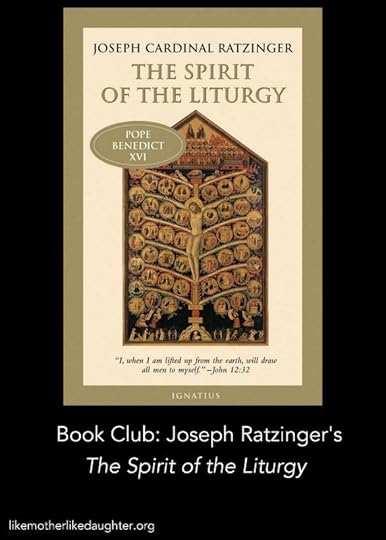Nature or history in worship? Or both? ~ The Spirit of the Liturgy: A Book Club

{Book Club: The Spirit of the Liturgy}
I hope you will read along in this book club (or just read my posts, that’s okay): Joseph Ratzinger’s The Spirit of the Liturgy.
(When you buy something via our Amazon affiliate link, a little cash rolls our way… just a little. Thanks!)
I’ll post on Fridays, although for this longer book, perhaps not every Friday. I’ll give you your homework, I’ll talk about what we read, we’ll discuss in the comments. Even if you read later, the comments will still be open.
Last time: Apostasy or Worship?
Homework: Read Chapter Three of Part I.
Chapter Two, Part I: Liturgy — Cosmos — History
In the previous chapter we read about how God intervened in history to make clear what He wanted worship to be, both exteriorly and interiorly — the rules for worship and also for the interior disposition of those who worship: To go to a certain place but also to be different there by living a certain way.
The interesting question arises of how worship looks elsewhere. It seems that man always has the idea that the gods sustain the world, so he attempts to offer them propitiation for what seems to be their preoccupation with willfully ignoring, taunting, or harming humanity.
But in a funny way, this kind of worship leads to the sense of having power over the gods! Frighteningly, this power further affirms man’s suspicion that he can destroy himself. By the way, I find this a deep insight, kind of tossed off the way Ratzinger does, then coming back to sneak up on you and hit you hard: MAN IS SUFFERING FROM EXISTENTIAL ANXIETY. All because he was anxious to start with and got an anxiety ball rolling.
Anyway.
The Sabbath, God’s first covenant with man, offers freedom. Creation and covenant occur together: if creation as we can see becomes “the space for the covenant, the place where God and man meet one another… then it must be thought of as a space for worship.”
And thus we can see that it’s a mistake to misunderstand freedom and think of the Sabbath as “a pure vision of a liberated society as the goal of human history,” taken apart from creation itself. So very often if we disconnect the vision from the place, we end up with a sort of idealization that is ever receding into the future.
So how to understand this tension, the tension between worship as ideal and existing in the realm of the unseen, as well as the undeniable fact that it is rooted in creation — that creation is not some sort of receptacle to be tossed away, but has meaning in itself for salvation?
Actually, the whole of the rest of the book is going to be an answer to this question. Because it is the question! Somehow, true worship must take into account everything, and reconcile it all.
Step by step, we will get there…
I love the paragraph, beginning on the bottom of page 26, to support this thesis of the unity of cosmos and history in God’s plan. It has to do with the giving of the ceremonial law in Exodus:
Seven times it says, “Moses did as the Lord had commanded him,” words that suggest that the seven-day work on the tabernacle replicates the seven-day work on creation. The account of the construction of the tabernacle ends with a kind of vision of the Sabbath. “So Moses finished the work. Then the cloud covered the tent of meeting, and the glory of the LORD filled the tabernacle.” (Ex 40:33f.) The completion of the tent anticipates the completion of creation. God makes his dwelling in the world. Heaven and earth are united. In this connection we should add that, in the Old Testament, the verb bara has two, and only two, meanings. First, it denotes the process of the world’s creation, the separation of the elements, through which the cosmos emerges out of chaos. Secondly, it denotes the fundamental process of salvation history, that is, the election, and separation of pure from impure, and therefore the inauguration of the history of God’s dealings with men. Thus begins the spiritual creation, the creation of the covenant, without which the created cosmos would be an empty shell. Creation and history, creation, history, and worship are in a relationship of reciprocity. Creation looks toward the covenant, but the covenant completes creation and does not simply exist along with it. Now if worship, rightly understood, is the soul of the covenant, then it not only saves mankind but is also meant to draw the whole of reality into communion with God.” [my emphasis]
The next couple of pages, 28-30, are very interesting for trying to express cosmos and history in terms of some sort of diagram. Is time an arrow, as Teilhard de Chardin would have us think? Is Jesus an “energy”? Is the future some sort of synthesis? (Spoiler: T. de C. is always going to make us feel pretty good while we read him, but is, as Jeeves would say, “fundamentally unsound, sir.”)
Rather than the arrow, Ratzinger reminds us of the cross… and then the circle. Neither the arrow nor the circle quite capture the Christian idea of how to think about reality, although each contains some element at least of experience; but it should come as no surprise that the cross is a better image!
If you are wondering about exitus and reditus (going and coming or returning), obviously Ratzinger has a lot to say about this motion — leaving and entering, falling and redemption. We are not going to get sidetracked into that, but we are just going to realize that everything — creation, history (especially as depicted in the Bible), and each person’s experience — is just this: coming from God, and going to Him. Our end is with Him. Also: He comes to us, in order to make this “return/reditus” possible.
Knowing this means that we can also know that sacrifice — that one factor common to all religions — does not mean destruction. A bit later in the chapter, Ratzinger tells us that the cross of Christ demonstrates that in dying, He makes us a gift of Himself, which of course “has nothing to do with destruction.”
Back to the diagram. Two things I want to throw out there for your delectation, figure-of-the-cross-wise, related to exitus/reditus and the cosmos:
First, when viewed from earth, even though we speak of the stars as circling in the sky, we observe a “cross-shaped movement” in the planets’ occasional retrograde motion.
Second, that cross made by the stars (planets) reminded me of a time that Suki and I heard a Bach scholar performing and speaking about the Prelude and Fugue in C-sharp minor (BWV 849). I don’t have the time or space to delve in the significance of this work, but will merely point out that it too contains a “cross” motif (which also happens to be the “Bach motif” — the melody formed by the letters of his name) — undoubtedly meant to represent and actually present to the listener the image (or sound!) of Christ’s cross. You can read a little about the cross motif here, and give a listen. There’s another discussion (relating to a different Bach piece) here (scroll down).
My only point here being that actual things in the universe — natural things like the planets and artistic things like music — almost fling the cross at us, just when we think we’ve figured out the pattern.
I also want to plug my very own image or motif for how to represent the reality of worship, avoiding the closed-in-ness of the circle or the unreality of the arrow, and that is the spiral. In our book, The Little Oratory, David Clayton and I discuss how fitting the spiral is to imagine the Liturgical Year (which, as Pius XII says, is the way for us to encounter Jesus Christ). Each turn of the spiral returns to something that has gone before, but the whole is ascending to the heights of Heaven and our ultimate home.
But the spiral is only a good image if it’s grounded in the reality of the turning of the year, the cosmos, and the knowing of the past, history. Otherwise, it becomes an ascent that the “knowers” embrace, leaving the “simple ones” behind, and this is Gnosticism.
“In early Christianity, the clash with Gnosticism was the decisive struggle with its own identity.” This is an easy line to miss (because it’s near the bottom of p. 31), but it’s an important one. Gnosticism is the error that’s the easiest to fall into, the one that seems “most identifiable” with the Christian message. But you’ll know it by how it hates, precisely, matter and creation.
But here comes the Good Shepherd, to rescue the sheep from the thicket. Again, just as we get worked up trying to figure religion out and make it all work as it ought, Ratzinger cuts through with not only an image from the Bible, but the one image most appealing to the childlike in us (as opposed to that sophisticated philosopher strenuously attempting to get up to the heights on his own, that Gnostic!). “The shepherd who rescues him and takes him home is the Logos himself, the eternal Word, the eternal Meaning of the universe dwelling in the Son… Man is given a homecoming.”
“The circles of the cosmos and of history are now distinguished” in the Paschal participation. “The gift of freedom is the center of created as well as of divine being, and so the historical element has its own irrevocable meaning, but it is not for that reason separated from the cosmic element.” Christianity is new, but it “does not spurn” the old.
Thus it restores creation to its true identity.
Do share with us what you think of this chapter! I look forward to your comments!
Click here to see our previous discussion of Romano Guardini’s The Spirit of the Liturgy, which you can read free, online. You can also purchase it here, although be warned, this edition does not have the footnotes, which stinks .
.
The post Nature or history in worship? Or both? ~ The Spirit of the Liturgy: A Book Club appeared first on Like Mother Like Daughter.



